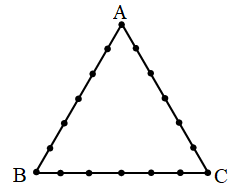Maths-
General
Easy
Question
If  for
for  , then
, then 
- 0
- 1
- 2
- 3
The correct answer is: 1
Related Questions to study
maths-
The largest value of r satisfying inequality 20Cr  20Cr – 1 is -
20Cr – 1 is -
The largest value of r satisfying inequality 20Cr  20Cr – 1 is -
20Cr – 1 is -
maths-General
maths-
A double decker bus can accommodate (u +  ) passengers, u in the upper deck and
) passengers, u in the upper deck and  in the lower deck. The number of ways in which the (u +
in the lower deck. The number of ways in which the (u +  ) passengers can be distributed in the two decks, if r (
) passengers can be distributed in the two decks, if r ( ) particular passengers refuse to go in the upper deck and S(
) particular passengers refuse to go in the upper deck and S( u) refuse to sit in the lower deck, is -
u) refuse to sit in the lower deck, is -
A double decker bus can accommodate (u +  ) passengers, u in the upper deck and
) passengers, u in the upper deck and  in the lower deck. The number of ways in which the (u +
in the lower deck. The number of ways in which the (u +  ) passengers can be distributed in the two decks, if r (
) passengers can be distributed in the two decks, if r ( ) particular passengers refuse to go in the upper deck and S(
) particular passengers refuse to go in the upper deck and S( u) refuse to sit in the lower deck, is -
u) refuse to sit in the lower deck, is -
maths-General
maths-
Domain of f(x) = log10(log10(1 + x3)) is -
Domain of f(x) = log10(log10(1 + x3)) is -
maths-General
chemistry-
The correct orders about compounds I and II are:
i) 
ii) 
The correct orders about compounds I and II are:
i) 
ii) 
chemistry-General
chemistry-
Which of the following is correct method for separating a mixture of following compounds?

Which of the following is correct method for separating a mixture of following compounds?

chemistry-General
chemistry-
The order in which the reagent must be used to separate the compound I - IV is:

The order in which the reagent must be used to separate the compound I - IV is:

chemistry-General
chemistry-
Decreasing order of solubility of following compounds is:
i) 
ii) 
iii) 
iv) 
Decreasing order of solubility of following compounds is:
i) 
ii) 
iii) 
iv) 
chemistry-General
chemistry-
Which of the following statement is correct about tropolone?

Which of the following statement is correct about tropolone?

chemistry-General
chemistry-
In which case first has higher solubility than second?
I) Phenol, Benzene
II) Nitrobenzene, Phenol
III) o–Hydroxybenzaldehyde, p–Hydroxy benzaldehyde
IV) CH3CHO, CH3–O–CH3
V) o–Nitrophenol, p–Nitrophenol
VI) 
In which case first has higher solubility than second?
I) Phenol, Benzene
II) Nitrobenzene, Phenol
III) o–Hydroxybenzaldehyde, p–Hydroxy benzaldehyde
IV) CH3CHO, CH3–O–CH3
V) o–Nitrophenol, p–Nitrophenol
VI) 
chemistry-General
chemistry-
Arrange the following in decreasing order of their solubility in water

Arrange the following in decreasing order of their solubility in water

chemistry-General
maths-
18 points are indicated on the perimeter of a triangle ABC (see figure). How many triangle are there with vertices at these points ?

18 points are indicated on the perimeter of a triangle ABC (see figure). How many triangle are there with vertices at these points ?

maths-General
Maths-
If A and B are two events such that  and
and  then A and B are
then A and B are
If A and B are two events such that  and
and  then A and B are
then A and B are
Maths-General
maths-
Number of rectangles in the grid shown which are not squares is:

Number of rectangles in the grid shown which are not squares is:

maths-General
maths-
If  and
and  then
then 
If  and
and  then
then 
maths-General
chemistry-
The correct order of solubility in water is:
a) CH3OH
b) CH3CH2OH
c) 
d) 
The correct order of solubility in water is:
a) CH3OH
b) CH3CH2OH
c) 
d) 
chemistry-General



